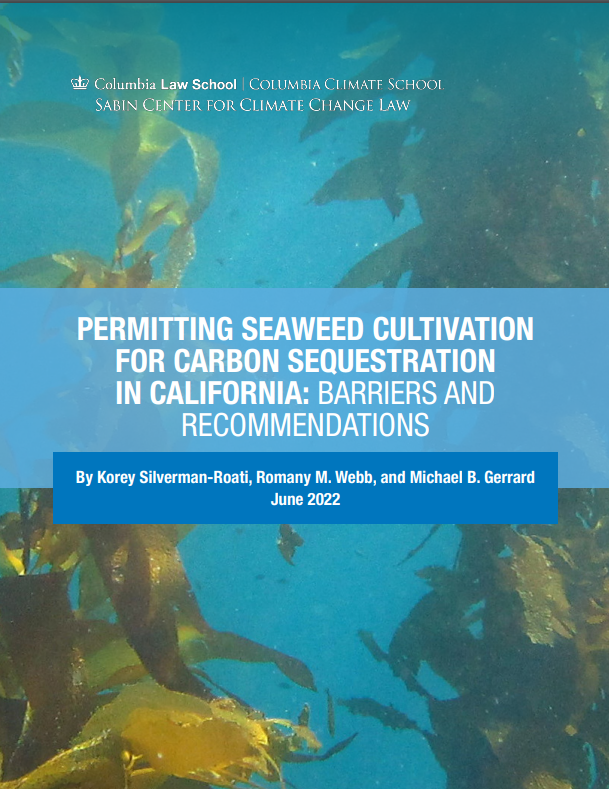A new report published today by the Sabin Center examines the laws governing international transport of carbon dioxide for sequestration. We focus, specifically, on the shipping of carbon dioxide that was captured in Europe to the United States for sequestration there. Much of the report would also be relevant to the shipping of carbon dioxide between other regions, though domestic laws at either end of the trip may also be relevant.
The issue of cross-border shipping of carbon dioxide for sequestration is of academic and practical interest. As previously reported on this blog, there were important developments in Europe last year, with the unprecedented shipping of carbon dioxide from Belgium for sequestration under the Danish North Sea; and, more recently, with the bilateral agreement signed between France and Denmark enabling carbon dioxide sequestration in the latter as well as last week’s bilateral agreements signed between Norway, France, Belgium, Denmark, the Netherlands and Sweden enabling sequestration in Norway. Momentum is also increasing in the United States, with a number of large carbon sequestration facilities being developed around the country. Several of those facilities will be located in Texas and Louisiana on or near the coast of the Gulf of Mexico, making them easily accessible to ships carrying carbon dioxide from overseas.
Main Contributions of the Report
The report, which is the first to comprehensively study international transport of carbon dioxide, makes several original contributions. First, it highlights the current legal uncertainties involving the cross-border shipping of carbon dioxide for sequestration. Second, it illustrates how market-based mechanisms under the Paris Climate Agreement do and do not relate to carbon dioxide shipping and sequestration, and the need for clarification. Third, the report provides a detailed analysis of the domestic U.S. laws applicable to the cross-border shipping and sequestration of carbon dioxide, and analyzes the legal consequences of the construction of a pier (or jetty) to enable the receipt of carbon dioxide shipped from overseas. Finally, liability regimes studied go beyond maritime conventions to include contractual liability and U.S. admiralty and maritime jurisdiction.
Ultimately, the report is grounded in a global perspective, including regional agreements involving developing countries, for instance, departing from the Eurocentric approach that has prevailed in the existing literature so far.
Introduction and Chapter 2: Relevance of the Topic, Basic Concepts, and Main Climate Treaties
Chapter 1 of the report introduces essential definitions and details the academic and practical interest in the cross-border shipping of carbon dioxide for sequestration.
Chapter 2 provides a technical overview of each of the three stages of the cross-border carbon capture and sequestration chain: (1) capture from point sources, (2) marine transportation from the country of capture to the place of storage, and (3) underground storage and utilization. It also discusses carbon dioxide removal (CDR) process that may create additional demand for cross-border transport and storage of carbon dioxide. In addition, Chapter 2 contextualizes the role of CCS technology in international climate agreements, examining the main reports by international actors on CCS, including studies by the International Energy Agency (IEA) and the Intergovernmental Panel on Climate Change (IPCC).
Chapter 3: The Applicable International Legal Framework
Chapter 3 zooms in to the international treaties applicable to the cross-border transportation of carbon dioxide for permanent storage overseas. It is premised on the fact that international agreements on what constitutes a hazardous or toxic substance are not black and white. Global definitions of “hazardous” and “toxic” substances may be interpreted differently across domestic regulations. Adding to this complexity, international definitions of “hazardous” and “toxic” substances may depend on domestic regulations. Similarly, there are often subtle distinctions between the movement of waste and dumping; while these two activities are not necessarily related, one may follow the other in practice. Finally, the transboundary movement of carbon dioxide raises difficult questions on how to classify carbon dioxide under international treaties that were drafted prior to the development of CCS technologies.
In such a complex setting, Chapter 3 focuses on international agreements that may affect the cross-border transportation of carbon dioxide for sequestration. It begins by examining the London Convention and Protocol, which create arguably the most important legal framework governing the regulation of cross-border carbon dioxide transportation and permanent storage. Next, this chapter provides an analysis of the Basel and Bamako Conventions.
Following the more in-depth analysis of the above international treaties, Chapter 3 then briefly outlines the potential implications of the following treaties and agreements for the transboundary movement of carbon dioxide: UNCLOS (United Nations Convention on the Law of the Sea); the High Seas Treaty or BBNJ (United Nations Convention on the Law of the Sea on the Conservation and Sustainable Use of Marine Biological Diversity of Areas Beyond National Jurisdiction); MARPOL (International Convention for the Prevention of Pollution from Ships); OSPAR (Convention for the Protection of the Marine Environment of the North-East Atlantic); the HNS Convention (International Convention on Liability and Compensation for Damage in Connection with the Carriage of Hazardous and Noxious Substances by Sea); the OECD Wastes Decision; and specific U.S. bilateral treaties involving the transportation of hazardous waste.
Chapter 4: How the International Shipping of Carbon Dioxide may fit under NDCs and Market-Based Mechanisms in Article 6 of the Paris Agreement
Chapter 4 pivots to how the international shipping of carbon dioxide from the European Union for permanent storage in the United States may fit under Nationally Determined Contributions (NDCs) and the market-based mechanisms in Article 6 of the Paris Agreement.
Cross–border CCS operations have specific and detailed rules under the emissions inventories and NDCs required for parties to the Paris Agreement. The transfer and storage of carbon dioxide from direct air capture and other carbon dioxide removal processes, however, have yet to be contemplated in the guidelines.
Chapter 4 highlights the complexities involved in the integration of the cross-border shipping of carbon dioxide into the market-based mechanisms of the Paris Agreement. It finds that currently this integration presents significant challenges. While some of these challenges may be addressed at upcoming meetings of the parties to the Paris Agreement, many uncertainties remain and could discourage investment and innovation in the field.
Chapter 5: The U.S. Federal Legislation and Four U.S. States’ Paradigmatic Experiences
Chapter 5 reviews the domestic U.S. legislation that may be applicable to the international shipping of carbon dioxide for permanent storage in the United States. It analyzes eventual requirements that current pipeline regulations may impose regarding purity standards and specifications for carbon dioxide streams.
Chapter 5 discusses the domestic laws governing carbon dioxide transportation, analyzing specifically the Marine Protection, Research, and Sanctuaries Act (MPRSA), the Hazardous Materials Transportation Act (HMTA), and the Act to Prevent Pollution from Ships (APPS). It also discusses the domestic laws governing carbon dioxide storage, analyzing the Safe Drinking Water Act (SDWA), the Resource Conservation and Recovery Act (RCRA), and the Outer Continental Shelf Lands Act (OCSLA). It finds that there is no comprehensive domestic legal framework regulating the cross-border transportation of carbon dioxide from a foreign country for permanent storage in the United States.
Following the discussion on federal laws, Chapter 5 outlines current state experiences in handling the transportation of carbon dioxide for permanent storage. It primarily examines how key states—North Dakota, Wyoming, Louisiana, and Texas—have implemented provisions under the SDWA.
Chapter 6: The NEPA Review and a Practical Inquiry regarding the Construction of a Pier or Jetty
Chapter 6 discusses the environmental reviews that may be required under the National Environmental Policy Act (NEPA) and how the 2023 amendments to NEPA will affect this review processes. This chapter specifically identifies the actions in the CCS chain that may trigger a NEPA review and explores the requirements for conducting such a review, including the need to analyze direct, cumulative, and indirect effects.
Finally, Chapter 6 presents the domestic laws governing a specific practical scenario involving in the construction of a new pier or jetty to assist in the final stages of transportation of the carbon dioxide for permanent storage chain.
Chapter 7: The Different Liability Regimes pertinent to the Cross-Border Shipping of Carbon Dioxide
Chapter 7 analyzes the liability regimes involved in cross-border shipping of carbon dioxide. The chapter explores key International Maritime Organization (IMO) conventions that apply to both the regulation and liability of shipping carbon dioxide. Chapter 7 also outlines the main issues of contractual liability applicable to carbon dioxide carriers, presenting an analysis of the different liability regimes under both the relevant IMO conventions as well as parties’ autonomy based on contract law. Chapter 7 concludes with a study about the main legal issues involving admiralty and maritime jurisdiction.
Preparation of this report was funded by Peter G. Livanos, chairman of EcoLog Ltd. The Sabin Center is solely responsible for its content.
Read the full report here.






